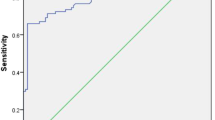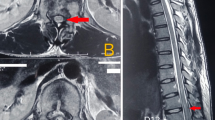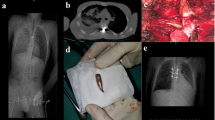Abstract
Study design:
Prospective observational study.
Objectives:
To describe the correlation between CCL-2, CCL-3, CCL-4 and CXCL-5 serum levels and remission after traumatic spinal cord injury (SCI) in a human protocol compared with animal studies.
Setting:
Germany, Rhineland-Palatinate (Rheinland-Pfalz).
Methods:
We examined the serum levels of CCL-2, CCL-3, CCL-4 and CXCL-5 over a 12-week period; in particular, at admission and 4, 9 and 12 h, 1 and 3 days and 1, 2, 4, 8 and 12 weeks after trauma. According to our study design, we matched 10 patients with TSCI and neurological remission with 10 patients with an initial ASIA A grade and no neurological remission. In all, 10 patients with vertebral fracture without neurological deficits served as control. Our analysis was performed using a Luminex Cytokine Panel. Multivariate logistic regression models were used to examine the predictive value with respect to neurological remission vs no neurological remission.
Results:
The results of our study showed differences in the serum expression patterns of CCL-2 in association with the neurological remission (CCL-2 at admission P=0.013). Serum levels of CCL-2 and CCL-4 were significantly different in patients with and without neurological remission. The favored predictive model resulted in an area under the curve (AUC) of 93.1% in the receiver operating characteristic (ROC) analysis.
Conclusions:
Our results indicate that peripheral serum analysis is a suitable concept for predicting the patient’s potential for neurological remission after TSCI. Furthermore, the initial CCL-2 concentration provides an additional predictive value compared with the NLI (neurological level of injury). Therefore, the present study introduces a promising approach for future monitoring concepts and tracking techniques for current therapies. The results indicate that future investigations with an enlarged sample size are needed in order to develop monitoring, prognostic and scoring systems.
Similar content being viewed by others
Log in or create a free account to read this content
Gain free access to this article, as well as selected content from this journal and more on nature.com
or
References
Rowland JW, Hawryluk GW, Kwon B, Fehlings MG . Current status of acute spinal cord injury pathophysiology and emerging therapies: promise on the horizon. Neurosurg Focus 2008; 25: E2.
Boakye M, Leigh BC, Skelly AC . Quality of life in persons with spinal cord injury: comparisons with other populations. J Neurosurg Spine 2012; 17: 29–37.
Biglari B, Buchler A, Reitzel T, Swing T, Gerner HJ, Ferbert T et al. A retrospective study on flap complications after pressure ulcer surgery in spinal cord-injured patients. Spinal Cord 2014; 52: 80–83.
Ito Y, Sugimoto Y, Tomioka M, Kai N, Tanaka M . Does high dose methylprednisolone sodium succinate really improve neurological status in patient with acute cervical cord injury?: a prospective study about neurological recovery and early complications. Spine 2009; 34: 2121–2124.
Kwon BK, Okon EB, Plunet W, Baptiste D, Fouad K, Hillyer J et al. A systematic review of directly applied biologic therapies for acute spinal cord injury. J Neurotrauma 2011; 28: 1589–1610.
Evaniew N, Belley-Cote EP, Fallah N, Noonan VK, Rivers CS, Dvorak MF . Methylprednisolone for the treatment of patients with acute spinal cord injuries: systematic review and meta-analysis. J Neurotrauma 2015; 33: 468–481.
Walters BC, Hadley MN, Hurlbert RJ, Aarabi B, Dhall SS, Gelb DE et al. Guidelines for the management of acute cervical spine and spinal cord injuries: 2013 update. Neurosurgery 2013; 60: 82–91.
Moghaddam A, Child C, Bruckner T, Gerner HJ, Daniel V, Biglari B . Posttraumatic inflammation as a key to neuroregeneration after traumatic spinal cord injury. Int J Mol Sci 2015; 16: 7900–7916.
Biglari B, Swing T, Child C, Buchler A, Westhauser F, Bruckner T et al. A pilot study on temporal changes in IL-1beta and TNF-alpha serum levels after spinal cord injury: the serum level of TNF-alpha in acute SCI patients as a possible marker for neurological remission. Spinal Cord 2015; 53: 510–514.
Campbell SJ, Perry VH, Pitossi FJ, Butchart AG, Chertoff M, Waters S et al. Central nervous system injury triggers hepatic CC and CXC chemokine expression that is associated with leukocyte mobilization and recruitment to both the central nervous system and the liver. Am J Pathol 2005; 166: 1487–1497.
Stanimirovic D, Satoh K . Inflammatory mediators of cerebral endothelium: a role in ischemic brain inflammation. Brain Pathol 2000; 10: 113–126.
Yokobori S, Zhang Z, Moghieb A, Mondello S, Gajavelli S, Dietrich WD et al. Acute diagnostic biomarkers for spinal cord injury: review of the literature and preliminary research report. World Neurosurg 2015; 83: 867–878.
Tyagi P, Kadekawa K, Kashyap M, Pore S, Yoshimura N . Spontaneous recovery of reflex voiding following spinal cord injury mediated by anti-inflammatory and neuroprotective factors. Urology 2016; 88: 57–65.
Lee SI, Jeong SR, Kang YM, Han DH, Jin BK, Namgung U et al. Endogenous expression of interleukin-4 regulates macrophage activation and confines cavity formation after traumatic spinal cord injury. J Neurosci Res 2010; 88: 2409–2419.
Brambilla R, Bracchi-Ricard V, Hu WH, Frydel B, Bramwell A, Karmally S et al. Inhibition of astroglial nuclear factor kappaB reduces inflammation and improves functional recovery after spinal cord injury. J Exp Med 2005; 202: 145–156.
Rizzo JA, Burgess P, Cartie RJ, Prasad BM . Moderate systemic hypothermia decreases burn depth progression. Burns 2013; 39: 436–444.
Kwon BK, Streijger F, Hill CE, Anderson AJ, Bacon M, Beattie MS et al. Large animal and primate models of spinal cord injury for the testing of novel therapies. Exp Neurol 2015; 269: 154–168.
Kwon BK, Stammers AM, Belanger LM, Bernardo A, Chan D, Bishop CM et al. Cerebrospinal fluid inflammatory cytokines and biomarkers of injury severity in acute human spinal cord injury. J Neurotrauma 2010; 27: 669–682.
Biglari B, Buchler A, Swing T, Biehl E, Roth HJ, Bruckner T et al. Increase in soluble CD95L during subacute phases after human spinal cord injury: a potential therapeutic target. Spinal Cord 2013; 51: 183–187.
Biglari B, Buchler A, Swing T, Child C, Biehl E, Reitzel T et al. Serum sCD95L concentration in patients with spinal cord injury. J Int Med Res 2015; 43: 250–256.
Ferbert T, Child C, Graeser V, Swing T, Akbar M, Biglari B et al. Tracking spinal cord injury: differences in cytokine expression of IGF-1, TGF- beta1 and sCD95L can be measured in blood samples and corresponds to neurological remission in a 12 week follow-up. J Neurotrauma 2016; 34: 607–614.
Moghaddam A, Heller R, Daniel V, Swing T, Akbar M, Gerner HJ et al. Exploratory study to suggest the possibility of MMP-8 and MMP-9 serum levels as early markers for remission after traumatic spinal cord injury. Spinal Cord 2016; 54: 957–960.
Moghaddam A, Sperl A, Heller R, Gerner HJ, Biglari B . sCD95L in serum after spinal cord injury. Spinal Cord 2016; 54: 957–960.
Moghaddam A, Sperl A, Heller R, Kunzmann K, Graeser V, Akbar M et al. Elevated serum insulin-like growth factor 1 levels in patients with neurological remission after traumatic spinal cord injury. PLoS ONE 2016; 11: e0159764.
Kirshblum SC, Burns SP, Biering-Sorensen F, Donovan W, Graves DE, Jha A et al. International standards for neurological classification of spinal cord injury (revised 2011). J Spinal Cord Med 2011; 34: 535–546.
Audigé L . Development and validation of a new generation for spine injury classification. Spine Classification and Severity Measures, 1st edn. Thieme: Stuttgart. 2009, pp 503–507.
Akaike H Akaike’s information criterion. International Encyclopedia of Statistical Science. Springer. 2011, pp 25.
R Development Core Team R: A Language and Environment for Statistical Computing. R Foundation for Statistical Computing: Vienna, Austria. 2015.
Robin X, Turck N, Hainard A, Tiberti N, Lisacek F, Sanchez JC et al. pROC: an open-source package for R and S+ to analyze and compare ROC curves. BMC Bioinformatics 2011; 12: 77.
Wickham H . ggplot2: Elegant Graphics for Data Analysis. Springer-Verlag: New York, USA. 2009.
Moghaddam A, Muller U, Roth HJ, Wentzensen A, Grutzner PA, Zimmermann G . TRACP 5b and CTX as osteological markers of delayed fracture healing. Injury 2011; 42: 758–764.
Müller ME, Nazarian S, Koch P, Schatzker J . The Comprehensive Classification of Fractures of Long Bones. Springer Science & Business Media. 2012.
Zheng Y, Morris A, Sunkara M, Layne J, Toborek M, Hennig B . Epigallocatechin-gallate stimulates NF-E2-related factor and heme oxygenase-1 via caveolin-1 displacement. J Nutr Biochem 2012; 23: 163–168.
Paul D, Ge S, Lemire Y, Jellison ER, Serwanski DR, Ruddle NH et al. Cell-selective knockout and 3D confocal image analysis reveals separate roles for astrocyte-and endothelial-derived CCL2 in neuroinflammation. J Neuroinflamm 2014; 11: 10.
Roberts TK, Eugenin EA, Lopez L, Romero IA, Weksler BB, Couraud PO et al. CCL2 disrupts the adherens junction: implications for neuroinflammation. Lab Investig 2012; 92: 1213–1233.
Mojsilovic-Petrovic J, Callaghan D, Cui H, Dean C, Stanimirovic DB, Zhang W . Hypoxia-inducible factor-1 (HIF-1) is involved in the regulation of hypoxia-stimulated expression of monocyte chemoattractant protein-1 (MCP-1/CCL2) and MCP-5 (Ccl12) in astrocytes. J Neuroinflamm 2007; 4: 12.
Mildner A, Mack M, Schmidt H, Bruck W, Djukic M, Zabel MD et al. CCR2+Ly-6Chi monocytes are crucial for the effector phase of autoimmunity in the central nervous system. Brain 2009; 132: 2487–2500.
Shechter R, Miller O, Yovel G, Rosenzweig N, London A, Ruckh J et al. Recruitment of beneficial M2 macrophages to injured spinal cord is orchestrated by remote brain choroid plexus. Immunity 2013; 38: 555–569.
Bank M, Stein A, Sison C, Glazer A, Jassal N, McCarthy D et al. Elevated circulating levels of the pro-inflammatory cytokine macrophage migration inhibitory factor in individuals with acute spinal cord injury. Arch Phys Med Rehabil 2015; 96: 633–644.
Kiguchi N, Maeda T, Kobayashi Y, Fukazawa Y, Kishioka S . Macrophage inflammatory protein-1alpha mediates the development of neuropathic pain following peripheral nerve injury through interleukin-1beta up-regulation. Pain 2010; 149: 305–315.
Quandt J, Dorovini-Zis K . The beta chemokines CCL4 and CCL5 enhance adhesion of specific CD4+ T cell subsets to human brain endothelial cells. J Neuropathol Exp Neurol 2004; 63: 350–362.
Acknowledgements
The present study has been funded by the AO foundation with an amount of 6700 SFR. We are grateful for their support. We additionally thank Martina Kutsche-Bauer for performing the Luminex analysis. Statistical consulting was provided by the Insitut for Biometrics and Bioinformatics, University of Heidelberg.
Author contributions
AM and BB conceived and designed the study; AM, RAH and BB performed the patient recruitment and collection of blood samples; VDl contributed materials and analysis tools and was responsible for the measurement of the data; RAH and KK analyzed the data; AM and RAH wrote the paper. MA, TFR, TS, PAG, GS and PH revised the paper.
Author information
Authors and Affiliations
Corresponding author
Ethics declarations
Competing interests
The authors declare no conflict of interest.
Rights and permissions
About this article
Cite this article
Heller, R., Raven, T., Swing, T. et al. CCL-2 as a possible early marker for remission after traumatic spinal cord injury. Spinal Cord 55, 1002–1009 (2017). https://doi.org/10.1038/sc.2017.69
Received:
Revised:
Accepted:
Published:
Issue date:
DOI: https://doi.org/10.1038/sc.2017.69
This article is cited by
-
Acute spinal cord injury serum biomarkers in human and rat: a scoping systematic review
Spinal Cord Series and Cases (2024)
-
Prognostic value of the systemic inflammatory index (SII) and systemic inflammatory response index (SIRI) in patients with traumatic spinal cord injury
European Spine Journal (2024)
-
Glial fibrillary acidic protein is a robust biomarker in cerebrospinal fluid and peripheral blood after traumatic spinal cord injury: a prospective pilot study
Acta Neurochirurgica (2023)
-
The inflammatory response and blood-spinal cord barrier integrity in traumatic spinal cord injury: a prospective pilot study
Acta Neurochirurgica (2022)
-
Improving Diagnostic Workup Following Traumatic Spinal Cord Injury: Advances in Biomarkers
Current Neurology and Neuroscience Reports (2021)



